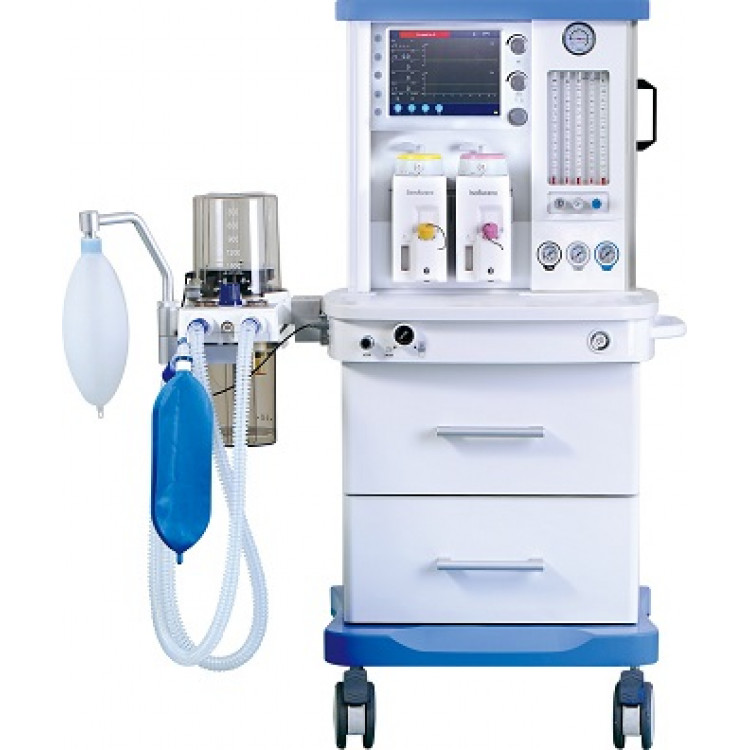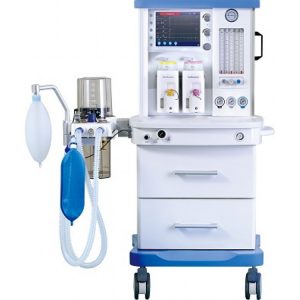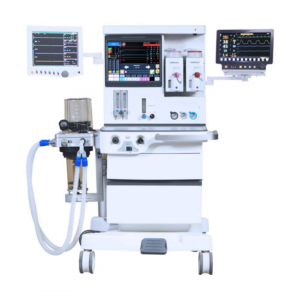
Anesthesia is the use of medicine to prevent or reduce the feeling of pain or sensation during surgery or other painful procedures (such as getting stitches). The anesthetic gas machine is also called the anesthesia workstation, or anesthesia delivery system. It is a medical device which generates and delivers a precisely-known but variable gas mixture, including anesthetizing and life-sustaining gases.

WTG Morton introduced the ether anaesthesia in 1846.
In 1917, a British anesthetist, Dr. Henry Edmund Gaskin Boyle invented a nitrous oxide, oxygen and ether anaesthesia machine which was referred to as the Boyle’s Apparatus or Boyle’s anaesthetic machine. This machine was a concept of continuous-flow machines that were based on the design of the Gwathmey Apparatus, using a ‘bubble through’ vaporizer. The gases were routed through to perforated tubes in a glass mixing chamber containing water. The rate of flow could be estimated by observing the force of the resulting bubbles this apparatus was widely popularized as the Boyle Bottle. It continued in production for over 50 years in Britain. In 1955, halothane was introduced to Great Britain and became very popular because it offered an explosive alternative to cyclopropane and ether.
The current anesthesia gas machine standard is ASTM F1850 . The European standard is EN740.
Five basic elements of anesthetic machines:
1. A high-pressure supply of gases.
2. Pressure gauges on O2 cylinders, with pressure reducing valves.
3. Flow meters.
4. Metal and glass vapouriser bottle for ether.
5. Breathing system.
Flowmeters.
The flow meter measures and indicates the rate of flow of gases and allows precise control of Ooxygen or nitrogen delivery to the vaporize gas outlet. They control the amount of gas being used in liters and, depending on the anesthesia machine, milliliters. An example of a flowmeter is a rotameter which measures the volumetric flow rate of fluid in a closed tube
Vaporisers.
They provide accurate dosage control when using volatile anaesthetics
A high-flow oxygen flush
It bypasses the flowmeters and vaporisers to provide pure oxygen at 30-75 litres/minute.
Pressure gauges, regulators and 'pop-off' valves
They indicate the pressure on the cylinder side of the regulator. The pressure regulator is used to decrease and maintain the gases at a safe operating level, usually about 50 psi. Pressure gauges monitor gas pressure throughout the system and protect the machine components and patient from excessive rises.
Battery backup for 30 minutes
Alarms
Grouped into high, medium, and low priority.
High priority alarms may not be silenced for more than 2 minutes.
Certain alarms and monitors must be automatically enabled and functioning prior to use, either through turning the machine on, or by following the pre-use checklist: breathing circuit pressure, oxygen concentration, exhaled volume or carbon dioxide (or both).
A high-priority pressure alarm must sound if user-adjustable limits are exceeded, if continuing high pressure is sensed, or for negative pressure.
Disconnect alarms may be based on low pressure, exhaled volume, or carbon dioxide.
Required monitors:
Exhaled volume
Inspired oxygen, with a high priority alarm within 30 seconds of oxygen falling below 18% (or a user-adjustable limit).
Oxygen supply failure alarm
A hypoxic guard system must protect against less than 21% inspired oxygen if nitrous oxide is in use.
Anesthetic vapor concentration must be monitored.
Pulse oximetry, blood pressure monitoring, and EKG are required
Pressure in the breathing circuit is limited to 12.5 kPa (125 cm water).
The electrical supply cord must be non-detachable or resistant to detachment.
The machine must have at least one oxygen cylinder attached.
The hanger yoke must be pin-indexed, have a clamping device that resists leaks, and contain a filter. It must have a check valve to prevent transfilling, and a cylinder pressure gauge. There must be cylinder pressure regulators. The machine must use pipeline gas as long as pipeline pressure is greater than 345 kPa (50 psi).
Flowmeters:
Single control for each gas. Each flow control next to a flow indicator. Uniquely shaped oxygen flow control knob. Valve stops (or some other mechanism) are required such that excessive rotation will not damage the flowmeter. Oxygen flow indicator is to the right side of a flowmeter bank. Oxygen enters the common manifiold downstream of other gases. An auxiliary oxygen flowmeter is strongly recommended. An oxygen flush is present, capable of 35-75 L/min flow which does not proceed through any vaporizers.
Vaporizers
Concentration-calibrated. An interlock must be present. Liquid level indicated, designed to prevent overfilling. "Should" use keyed-filler devices. No discharge of liquid anesthetic occurs from the vaporizer even at maximum fresh gas flow. Only one common gas outlet at 22 mm outer diameter, 15 mm inner diameter, which is designed to prevent accidental disconnection. Pipeline gas supply. Pipeline pressure gauge. Inlets for at least oxygen and nitrous oxide. DISS protected. In line filter. Check valve.
Checklist must be provided (it may be electronic, or performed manually by the user)
A digital data interface must be provided
Issues that arise with oxygenation account for a great number of the serious mishaps and complications. Misuse of anesthesia gas delivery systems is three times more likely than failure of the device to cause equipment-related adverse outcomes. These problems are attributed to human errors than to equipment failures. An operator’s lack of familiarity with the equipment or a failure to check machine function, or both, are the most frequent causes.

https://www.woodlibrarymuseum.org/museum/item/92/boyle-apparatus
https://en.wikipedia.org/wiki/Anaesthetic_machine
https://www.ncbi.nlm.nih.gov/pmc/articles/PMC3821260/
https://www.anaesthesiauk.com/default.aspx
https://accessanesthesiology.mhmedical.com/content.aspx?bookid=564§ionid=42800534
You must be logged in to post a comment.
Need Theatre equipment s and accessories
Hi Janet, we shall send you our price list
Sent me price list for theatre accessories
please share the list of specific accessories you need on our email. [email protected]
Share with me the prices for different anaesthesia machine with control and support modes of ventilation and vital sign monitors you have. Thank you.
I would like to know whether you supply hamson anaesthesia machines
And at how much
Hi Isaac, we don't have the Hamson available in stock. Please call us on 0722932625 for more information
Do you have Mapleson F paediatric circuit... if yes whats the price
Hello Caleb, it is not available